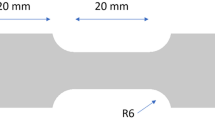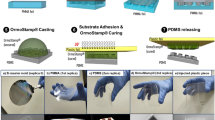Abstract
Stereolithography (SLA) is a rapid prototyping technique based on photo-polymerization of liquid resin by laser source. The process is well known for many prototyping activities and additive manufacturing operations and started to show its potential in bio-MEMS applications like lab-on-chips. Unfortunately, the strong linkage between process parameters setting and final properties of downscaled devices is at present the primary cause of design failure and delays. In fact, it is crucial to control geometrical tolerances and mechanical properties. The aim of this work is to investigate the interactions between the most influent SLA process parameters on final mechanical and topological properties of biomedical polymers. The cross-interactions of polymer transparency, port-curing time and hatching direction are analyzed. The terms of comparison used to analyze process performances are geometrical dimensions and mechanical properties (Young’s modulus, ultimate stress/strain). The analysis of variance (ANOVA) method is used to identify the factor of influence of each process parameter.




Similar content being viewed by others
References
André JC (2017a) From additive manufacturing to 3D/4D printing 1: from concepts to achievements. Wiley, Hoboken
André JC (2017b) From additive manufacturing to 3D/4D printing 2: current techniques, improvements and their limitations. Wiley, Hoboken
André JC (2017c) From additive manufacturing to 3D/4D printing 3: breakthrough innovations: programmable material, 4D printing and bio-printing. Wiley, Hoboken
Bhushan B, Caspers M (2017) An overview of additive manufacturing (3D printing) for microfabrication. Microsyst Technol 23:1117–1124
Bose S, Vahabzadeh S, Bandyopadhyay A (2013) Bone tissue engineering using 3D printing. Mater Today 16(12):496–504
Chen Q, Chen Q, Maccioni G, Ferrero S, Scaltrito L, Sacco A (2010) Fabrication of micro-structures on Nickel alloy by DPSS laser ablation technique for lab-on-chip applications. Proc SPIE Int Soc Opt Eng 7762:776239
Cho HS, Park WS, Choi BW, Leu MC (2000) Determining optimal parameters for stereolithographic processes via genetic algorithm. J Manuf Syst 19(1):18–27
Chockalingam K, Jawahar N, Chandrasekar U, Ramanathan KN (2008) Establishment of process model for part strength in stereolithography. J Mater Process Technol 208:348–365
De Pasquale G (2013) Experimental analysis of viscous and material damping in microstructures through the interferometric microscopy technique with climatic chamber. J Sound Vib 332:4103–4121
De Pasquale G (2015) Biomechanical energy harvesting: design, testing, and future trends in healthcare and human-machines interfacing. In: Mescia L, Losito O, Prudenzano F (eds) FInnovative materials and systems for energy harvesting applications. IGI global—engineering science reference, USA. pp 290–340
De Pasquale G (2016) Artificial human joint for the characterization of piezoelectric transducers in self-powered telemedicine applications. Meccanica 51(9):2259–2275
De Pasquale G, Veijola T (2008) Comparative numerical study of FEM methods solving gas damping in perforated MEMS devices. Microfluid Nanofluid 5:517–528
De Pasquale G, Kim SG, De Pasquale D (2016) GoldFinger: wireless human–machine interface with dedicated software and biomechanical energy harvesting system. IEEE-ASME T Mech 21(1):565–575
Dulieu-Barton JM, Fulton MC (2000) Mechanical properties of a typical stereolithography resin. Strain 36(2):81–87
Gurr M, Mülhaupt R (2012) Rapid prototyping, in “polymer science: a comprehensive reference”. Elsevier 8:77–99
Jacobs PF (1992) Fundamentals in stereolithography. 3D Systems Inc., Valencia, California, USA
Karalekas DE, Agelopoulos A (2006) On the use of stereolithography built photoelastic models for stress analysis investigations. Mater Des 27:100–106
Lafleur JP, Jönsson A, Senkbeil S, Kutter JP (2016) Recent advances in lab-on-a-chip for biosensing applications. Biosens Bioelectron 76:213–233
Lantada AD, Sanchez BP, Murillo CG, Sotillo JU (2013) Fractals in tissue engineering: towards biomimetic cell-culture matrices, microsystems and microstructured implants. Expert Rev Med Device 10(5):1–20
Lynn-Charney C, Rosen DW (2000) Usage of accuracy models in stereolithography process planning. Rapid Prototyp J 6(2):77–86
Melchels FP, Feijen J, Grijpma DW (2010) A review on stereolithography and its applications in biomedical engineering. Biomaterials 31:6121–6130
Nee AY, Fuh JY, Miyazawa T (2001) On the improvement of the stereolithography (SL) process. J Mater Process Technol 113:262–268
Ratchev S, Koelemeijer S (2008) Micro-assembly technologies and applications. Springer, New York
Richter J, Jacobs PF (1991) The present state of accuracy in stereolithography. In: Proceedings of 2nd international conference on rapid prototyping, Dayton, Ohio (USA), pp 269–294
Salmoria GV, Ahrens CH, Beal VE, Pires AT, Soldi V (2009) Evalutaion of post-curing and laser manufacturing parameters on the properties of SOMOS 7110 photosensitive resin used in stereolithography. Mater Des 30:758–763
Solid Freeform Fabrication Proceedings Symposium, Austin, Texas (USA), 1993
Varadan VK, Varadan VV (2001) Micro stereo lithography and fabrication of 3D MEMS and their applications. Proc SPIE 4952:9–20
Ventola L, Scaltrito L, Ferrero S, Maccioni G, Chiavazzo E, Asinari P (2014) Micro-structured rough surfaces by laser etching for heat transfer enhancement on flush mounted heat sinks. J Phys Conf S 525:1–10
Wang WL, Cheah CM, Fuh JY, Lu L (1996) Influence of process parameters on stereolithography part shrinkage. Mater Des 17(4):205–213
Zhou JG, Herschovici D, Chen CC (2000) Parametric process optimization to improve the accuracy of rapid prototyped stereolithography parts. Int J Mach Tool Manuf 40:363–379
Author information
Authors and Affiliations
Corresponding author
Rights and permissions
About this article
Cite this article
De Pasquale, G., Bertana, V. & Scaltrito, L. Experimental evaluation of mechanical properties repeatability of SLA polymers for labs-on-chip and bio-MEMS. Microsyst Technol 24, 3487–3497 (2018). https://doi.org/10.1007/s00542-018-3753-1
Received:
Accepted:
Published:
Issue Date:
DOI: https://doi.org/10.1007/s00542-018-3753-1




